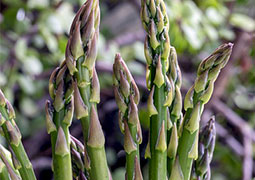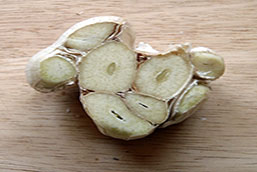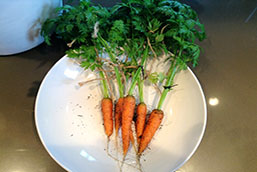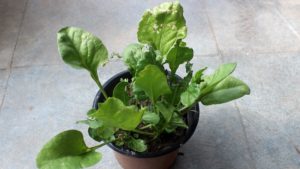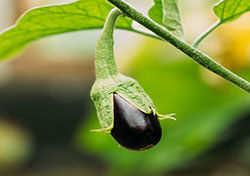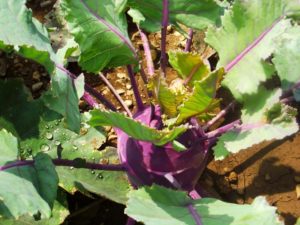Have you ever tried asparagus? This plant is most popular for being one of the best side dishes. This vegetable when cooked with butter goes well with steak, salmons, and other dishes. Let’s learn how you can grow Asparagus at home.
Hungry, now? This perennial plant adds tenderness and tastiness that goes well with tender and savory dishes. Eating it also happens to have a lot of benefits for you and your health. It is packed with B vitamins, Vitamin C, Calcium, and Iron.
Wanna know a secret? Asparagus is much better when fresh than buying from groceries. So, why not grow your own asparagus in your own backyard?
That’s why I grow them in my garden.
This plant is best to be planted during early spring. But take note also that it still grows well even on different climate circumstances, even extreme weather conditions.
Get an unlimited supply of your favorite fresh young shoots of asparagus right in your garden. Although it takes some time before you actually could harvest, the waiting would all be worth it.
That’s why I highly suggest that you start early or start now. After years of preparing, caring, and waiting, I’ve finally made a harvest, and I guarantee you that it’ll all be worth it. So ready your gardening tools and let’s start!
Grow at Home Your Own Asparagus
Before we start digging, let me give you first the “Introduction to Asparagus” lesson.
I’ll be honest with you, growing asparagus is really a challenge. You might encounter new botany lessons that you’ve never known before. For instance, this plant has male and female plants which could have different benefits for you.
It will also take some time. And when I say time, I mean years before we could actually harvest. All this might sound like a hassle, but I promise you harvesting your very own asparagus is really one proud moment.
It needs a big space to grow and fertilizer to maintain the nutrients over the years. While waiting for harvest might take 2-3 years, your plant could actually yield mature asparagus up to 10 – 20 years.
Just like other plants, it also needs continuous mulching, weeding, and proper watering. All these could make or break your first ever harvest, so pay attention to properly care for your plant.
This could be labor extensive, but the end result would truly be rewarding. It’s one plant on my bucket list, so I’m really excited to share this to you as well.
Everything You Need To Know From Planting To Harvest Asparagus
Now that you’ve learned a bit of growing asparagus, let’s get into the nitty gritty details to guide you through the process.
Planting Asparagus
When is the best time to plant asparagus?
Asparagus is a perennial plant, which means that it has a long life span like 20 to 30 years. Now, that’s a lot of asparagus.
Your plant will regrow and will yield a lot of asparagus every spring for the next few years.
That’s why early spring is also the best time to plant your asparagus. The plant goes well in different climate conditions, even on extreme weather. So don’t worry about the cold weather, you plant will still thrive no matter what.
How should I choose the right variety for me?
This is where it gets a bit tricky.
Asparagus plants are like humans; some varieties are female and some are male. While female asparagus carries and produces approximately 19,200 seeds, male asparagus yields bigger and thicker spears.
You could actually determine if it’s a male or a female of the plants by looking at some signs.
Male blooms have 6 stamens and one small useless pistil, and female blooms have 6 small non functional pistils and a three-lobed stamen.
Also, you could choose a specific variety to ensure you will grow male or female. For instance, Jersey Knight and Jersey Giant are primarily male plants.
I personally prefer the male varieties since it yields better asparagus than the female varieties.
Female varieties tend to be shorter and weaker since they exert energy in producing seeds.
Basically, male varieties should be used for commercial production, while the female varieties should be used for reproduction purposes. So for this project, male varieties would work best for you.
Should I use asparagus seeds or asparagus crowns?
There are two ways in planting asparagus. You could either plant with seeds or with crowns, but the best way to plant it is via asparagus crowns.
Using seeds might not be the best idea since it takes a lot of time and labor than crowns.
Plus, using crowns would give you a one year head start.
So instead of waiting 2-3 years for harvest using seeds, you could now harvest after 1-2 years.
I personally use one-year old crowns that the two-year old crowns. The latter won’t give you faster production; it would only produce the same as one-year old crown.
In addition, two-year old crowns might even suffer from transplant shock and might cause further delays.
Take note also that asparagus crowns are only available once a year in early spring, so place your orders immediately at the nearest nursery near you.
Before buying, check the roots for visible disease symptoms. Choose fresh and firm crowns on reputable nursery nearest to your location.
Where should I plant asparagus crowns?
Since asparagus plant could be harvested for the next 20 to 30 years, make sure to choose a prime spot that is conducive for the plant.
Find a spot in your backyard that has a good exposure of sunlight. Although asparagus could thrive with less exposure to sunlight, full sunlight could render the best results during harvest.
Check also the soil. This has to be planted on lighter soil since the crown should not be dampened with water.
Therefore, a soil that would easily dry well after watering and warm up in spring is best for the growth of asparagus.
Soil pH is also fundamental. For best results, have the soil tested on laboratories near you. pH of soil should be 6.0 to 8.0.
How do I prepare the soil?
Given the soil and drainage requirements of asparagus, this plant should be planted on raised beds.
For the actual planting, I recommend a four feet wide raised garden beds.
Before starting on the raised bed, make sure also that the soil is free from weeds. Although asparagus would be ready for harvest not after 3 years after, competition should not be tolerated.
Weed the entire area to remove weeds and roots.
Then, dig the soil and add compost and manure to add nutrients to the soil. I usually add a 2 to 4 inches of this to the soil to maintain good quality of soil that’s conducive for their growth.
How do I plant asparagus?
Now that we’ve prepared all the materials, you’re now ready to plant your first asparagus. This might be labor intensive, so gather your gardening materials. Let’s start digging, literally.
First, trench approximately 6 – 8 inches deep and a foot (12”) wide. This is to prevent them from being affected by annual weed control.
Then, place another trench that is 18 inches apart. Place also shovel of compost and a cup of all purpose organic fertilizer every 18 inches.
Rock phosphate and natural mineral powder is optional, but it’s a great way to ensure root strength.
Place the asparagus crown on the mound, while evenly spreading the roots. Afterwards, add 2 inches of soil to cover the crown. Then, water all trenches properly.
When you see a 2-3 inches growth on spears after nearly two years, add another 2-3 inches of soil. Do not submerge the entire spear in soil. Make sure that there’s still a small piece of the spear showing.
Continue adding soil as the spear grows up until you a time that you reached the surface. Slightly mound the soil to prevent puddling around the spears.
Growing Asparagus
Do I still need to thin my asparagus plants?
Since we planted through asparagus crowns, you won’t need to thin your garden bed. The right distance of 18 inches has already been made when you planted the crowns into the soil.
How do I maintain my asparagus plant?
- Mulching
Asparagus don’t work well with competition, so weeding should be religiously done. That’s why mulching is really important to prevent perennial weeds from taking over.
Start mulching the garden bed early on the process using shredded leaves and straw.
Afterwards, take notice of the season when applying mulch. For winter season, you might want to double the protection to provide better insulation to the base of the plant.
Replace it per season to ensure that diseases will not be transmitted through this form.
On the first two years, weed carefully since the roots of the plant are near the surface. Avoid being too intrusive to avoid damaging the roots of the plant.
2. Watering
Do you know that the natural habitats of asparagus are swamps and other wet places? That’s why the roots should always be moisturized.
For three to five years, watering is really important for plant growth, especially for root growth.
So if you live in a dry area, you might want to consider irrigation and soaker hose.
Which fertilizer should I use and when do I use it?
The Use of fertilizer is important in all plants to maintain nutrients in the soil which in turn results to healthy crops.
In the case of asparagus, keeping it healthy will yield harvestable crops for a very long time.
It usually take 2-3 years before you could harvest asparagus. Through this course of time it is really important to fertilize the soil since asparagus tends to dry out the nutrients from the soil.
For the first three years, fertilization is done to ensure strong roots and plant development. For this period, use a balanced amount of nitrogen, phosphorous, and potassium. This could be 10-10-10 or 15-15-15.
For mature plants (four years and above), you have the option to apply a balanced fertilizer or nitrogen-induce fertilizer (10-5-5), if your foliage is week. Apply this late spring or early summer.
Moreover, be very cautious when applying fertilizer to your plant, because it could burn the plant or the crowns.
I usually create a furrow in between the plants. I apply the fertilizer here to prevent it from damaging the crops.
After applying fertilizer, water the crops immediately to remove excess residue. It also helps in absorption of fertilizer into the soil.
How much sun does my asparagus plant need?
As mentioned before, this plant could withstand extreme weather conditions. It could be planted in a shaded area with partial sun exposure and it will still thrive.
But if you want the best results, make sure that your garden bed is with full sun exposure. This will yield better results.
Which climate better suits asparagus? (Best Hardiness Zones)
Generally speaking, asparagus could grow from Zone 3 to 10. This plant is best suited for temperate climate; however, different varieties of asparagus could withstand different weather conditions and hardiness zone.
That’s why it’s best to plant a variety of asparagus in your area.
Asparagus plant needs a 75 to 85 degrees Fahrenheit during the daytime and 60 to 70 degrees Fahrenheit during the nighttime.
The plant starts to produce new shoots when the temperature reaches up to 50 degrees Fahrenheit, which is why it regrows in spring.
How long does it take to grow asparagus?
Asparagus plant takes time to grow and produce harvestable crop.
The first two to three years would be for the plant to strengthen its roots and for plant development.
Afterwards, mature spears could be harvested. This could last up to 10-20 years, depending on the nutrients it has been receiving.
Moreover, the emergence of the mature spears could last up to four to six weeks on the second year. For the succeeding years, it could last up to six to eight weeks.
What are the common diseases and pests of asparagus?
Now that you’ve learned the basics of planting and growing of asparagus, let’s talk about the diseases that could ruin your asparagus harvest.
Since the edible part of the plant is the speas, you have to protect this part from all pests and diseases. Here are some of the most common pests and diseases of an asparagus plant.
- Asparagus Beetles
There are two types of beetles that could attack your plant. This could be metallic blue to black with yellow spots or orange with black spots.
The infestation of this pest could be associated both on the adult and larval forms. The adult feeds on the body and ferns of the plant. As a result the spears turn brown and plant weakens.
To prevent the damage, pay close attention to the bugs climbing on the spears. The presence of a few adult beetles could mean that you could still prevent them from further infestation. Do not spray insecticide as the best way to manage the pest is through its natural predator, tiny wasp.
2. Cutworms
Cutworms also feed on asparagus. They could be white or black in color and would appear during the harvest season, spring time.
They start by laying eggs on the soil and chewing on the spears as caterpillar. White cutworms climb to the tips to chew it, while the black cutworms chew on the lower portion of the spear. This results in spiral or crooked spears.
To manage this pest, implement good weeding practices to reduce egg and worm growth in the soil.
3. Crown Rot
This disease is caused by a fungi called Fusarium species. It is a soil borne disease that causes the browning of crown and rotting of plant which eventually leads to death.
You could see early symptoms of the disease through presence of reddish-brown lesions on the stems. The roots also have the same discoloration. Cutting the stems in half would also reveal discoloration.
This disease could spread exponentially and is really difficult, or nearly impossible to manage. That’s why prevention is the key.
All you could do is to make sure that the area is free from weeds and the crown you planted are free from this disease.
What other crops could I plant between the spaces of my asparagus plant?
Planting another plant beside asparagus is a great idea to save space, but you should be wary of picking the right plant. As some plants do not go well together, but some of them do.
For asparagus plant, tomatoes will be the best vegetable to plant near. They emit solanine that is a natural repellent against asparagus beetle.
In return, asparagus also releases a chemical that could prevent nematodes from infesting tomatoes.
I also plant comfrey, coriander, and dill since these repel some pests like aphids and spider mites that could damage the plant.
Try also beets, lettuce, and spinach as the tall ferns of the plant could give shading to these plants.
What are the crops should not be planted near asparagus?
Although garlic and onions are natural pest repellent, they don’t go well with asparagus in the garden bed. Due to the strong taste of these plants, it could alter the natural flavor of asparagus.
Do not plant potatoes either.
Harvesting Asparagus
Now that you’ve done basically all the steps to plant and grow asparagus, you’re ready to harvest. Here are the asparagus harvest do’s and don’ts
When is the best time to harvest asparagus?
Do not harvest yet on the first spring year. This year is dedicated for root and plant development, so harvest could be done on spring of the second year.
Keep in mind not to overharvest since the plant still needs to replenish its energy for next year.
For your first harvest, it would take 2-3 weeks. Look for harvest ready spears; this should be 6 to 8 feet long and at least half inch thick. If the diameter is less than one half inch, do not harvest it yet.
For mature plants like three years and older, harvest could take up to eight weeks.
Make sure you were able to harvest within harvest time period since spears could overmature and become woody.
To harvest, snap it directly using your fingers or use a knife to cut it off right above the ground.
Once the harvest duration ended, let the ferns grow after harvesting to replenish the nutrients for next year. You could expect a 4 to 6 feet high before fall.
Afterwards, wait for the foliage to turn brown or yellow, then cut the asparagus back to the ground. Leave a one inch space to let the plant regrow for harvest next year.
Now you could serve the asparagus of your labor to dinner.
What is the best way to store asparagus that I have harvested?
Asparagus plant does not have a long shelf life. It should be eaten within two to three days after harvest.
Before storing the crop in your fridge, clean it up first. First, brush away visible dirt and wash it lightly with cold water.
Be sure to dry it before storing to avoid mold growth.
Wrap the spears together with moist paper towel. Then, place it in a plastic bag before storing the fridge. The optimum spot for asparagus is on the crisper drawer of your refrigerator.
You could also place the spears in a cup of water to keep it hydrated, which could prolong its shelf life and maintain its freshness. Place an inch of clean water into the cup and store it in the fridge.
Featured Table
| Botanical Name | Asparagus officinalis |
| Plant Type | Vegetable |
| Sun Exposure | Full Sun |
| Soil Type | Sandy |
| Soil pH | 6.0 – 8.0l |
| Bloom Time | Spring |
| Flower Color | |
| Hardiness Zones | 3, 4, 5, 6, 7, 8, 9, 10 |

